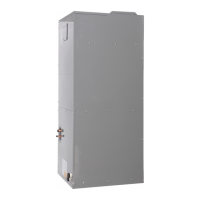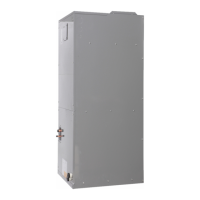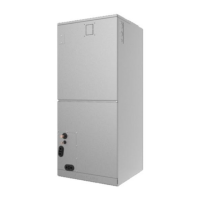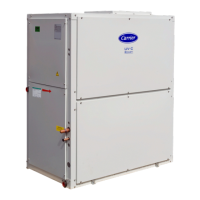40MBDAQ: Service Manual
Manufacturer reserves the right to change, at any time, specifications and designs without notice and without obligations.
15
TROUBLESHOOTING
This section provides the required flow charts to troubleshoot problems
that may arise.
NOTE: Information required in the diagnoses can be found either on
the wiring diagrams or in the appendix.
Required Tools:
The following tools are needed when diagnosing the units:
• Digital multimeter
• Screw drivers (Phillips and straight head)
•Needle−nose pliers
• Refrigeration gauges
Recommended Steps
1. Refer to the diagnostic table, see Table 6 on page 16, and determine
the problem at hand.
2. Go to the chart, see “DIAGNOSIS AND SOLUTION” on page 17,
and follow the steps in the chart for the selected problem.
For ease of service, systems are equipped with diagnostic code display
LED’s on both the indoor and outdoor units. The outdoor diagnostic
display is on the outdoor unit board and is limited to very few errors.
The indoor diagnostic display is a combination of flashing LED’s on the
display panel on the front of the unit. If possible always check the
diagnostic codes displayed on the indoor unit first. The diagnostic codes
for the indoor and outdoor units are listed in the appendix (see
“APPENDICES” on page 55.
Problems may occur that are not covered by a diagnostic code, however
are covered by the diagnostic flow charts. These problems are typical air
conditioning mechanical or electrical issues that can be corrected using
standard air conditioning repair techniques.
For problems requiring measurements at the control boards, note the
following:
1. Always disconnect the main power.
2. When possible, check the outdoor board first.
3. Start by removing the outdoor unit top cover.
4. Reconnect the main power.
5. Probe the outdoor board inputs and outputs with a digital multi-
meter referring to the wiring diagrams.
6. Connect the red probe to the hot signal and the black probe to the
ground or negative.
7. Note that some of the DC voltage signals are pulsating voltages for
signal. This pulse should be rapidly moving at all times when there
is a signal present.
8. If it is necessary to check the indoor unit board, disconnect the main
power first.
9. Next, remove the unit’s front cover and then the control box cover.
10. Carefully remove the indoor board from the control box, place it
face up on a plastic surface (not metal).
11. Reconnect the main power and repeat steps 5, 6, and 7.
12. Disconnect the main power before reinstalling the board to avoid a
shock hazard and board damage.
Safety
Electricity remains in the capacitors even when the power supply is shut off. Do not forget to discharge the electricity in the capacitor.
A220989
Fig. 21 — Capacitors
For other models, connect discharge resistance (approx.100Ù 40W) or soldering iron (plug) between +, - terminals of the electrolytic capacitor on the
contrary side of the outdoor PCB.
A220990
Fig. 22 — Discharging Position
NOTE: Figure 22 is for reference only.
Electrolytic Capacitors
(HIGH VOLTAGE! CAUTION!)

